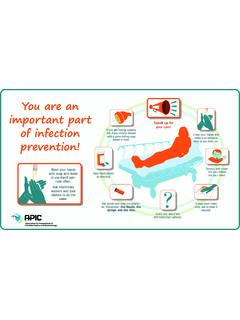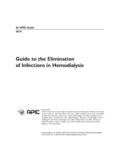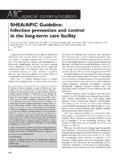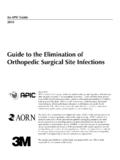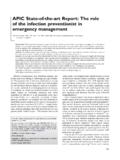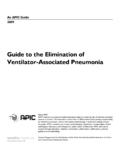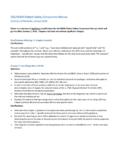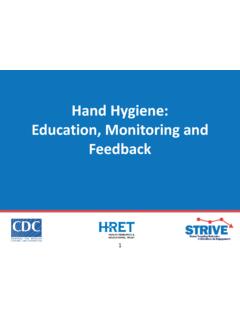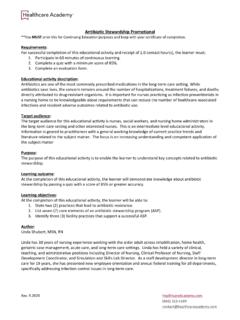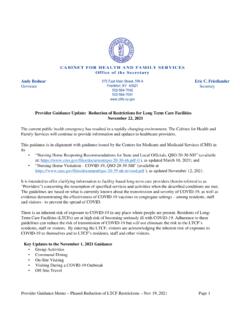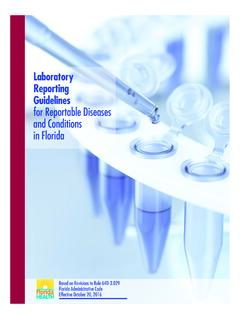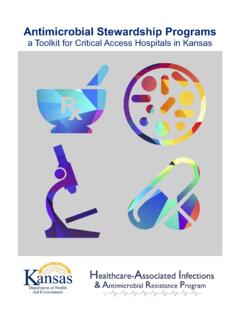Transcription of Guide to the Elimination of Clostridium difficile in ...
1 Guide to the Elimination of Clostridium difficile in Healthcare SettingsAbout APICAPIC s mission is to improve health and patient safety by reducing risks of infection and other adverse outcomes. The Association s more than 12,000 members have primary responsibility for infection prevention, control and hospital epidemiology in healthcare settings around the globe. APIC s members are nurses, epidemiologists, physicians, microbiologists, clinical pathologists, laboratory technologists and public health professionals. APIC advances its mission through education, research, consultation, collaboration, public policy, practice guidance and APIC Guide2008 Look for other topics in APIC s Elimination Guide Series, including: Catheter-Related Bloodstream infections Catheter-Related Urinary Tract infections Mediastinitis MRSA in Long-Term CareCopyright by 2008 APICAll rights reserved.
2 No part of this publication may be reproduced, stored in a retrieval system, or transmitted, in any form or by any means, electronic, mechanical, photocopying, recording, or otherwise, without prior written permission of the inquires about this document or other APIC products and services may be addressed to:APIC Headquarters1275 K Street, NWSuite 1000 Washington, DC 20005 Phone: : photo courtesy of of the bacterium Clostridium difficile made from an impression smear of 72hr anaerobe blood agar (1980). ISBN: 1-933013-37-0 For additional resources, please visit to the Elimination of Clostridium difficile in Healthcare SettingsASSOCIATION FOR PROFESSIONALS IN INFECTION CONTROL AND EPIDEMIOLOGY Table of Contents 1.
3 Acknowledgments ..4 2. Guide Overview.. 5 3. Pathogenesis and Changing Epidemiology of Clostridium difficile Infection (CDI) ..7 4. CDI in the Pediatric Population ..11 5. Modes of Transmission ..13 6. Diagnosis ..15 7. Surveillance ..18 8. Focusing on Prevention: Contact Precautions ..24 9. Focusing on Prevention: Hand Hygiene ..2710. Focusing on Prevention: Environmental Control ..3211. Tiered Response to C. difficile ..38 Summary of C. difficile Transmission Prevention Activities During Routine Infection Prevention and Control Responses ..38 Summary of Additional C. difficile Transmission Prevention Activities During Heightened Infection Prevention and Control Responses.
4 4012. Other Preventive Measures ..4213. Antimicrobial Stewardship and Clostridium difficile : A Primer for the Infection preventionist ..4314. Using a Systems Approach to the Elimination of Clostridium difficile Infection (CDI) ..4915. Glossary of Terms ..5416. Frequently Asked Questions ..5617. References ..61 Guide to the Elimination of Clostridium difficile in Healthcare Settings ASSOCIATION FOR PROFESSIONALS IN INFECTION CONTROL AND EPIDEMIOLOGYA cknowledgmentsThe challenges posed by Clostridium difficile represent some of the most difficult and alarming issues confronting infection prevention and control.
5 The elements involved in addressing this problem, as well as the changing epidemiology of C. difficile , have collided, resulting in a prevention and control perfect storm. This has already impacted the health and safety of patients, regardless of whether they receive care in a hospital, long-term care facility, outpatient setting, ambulatory care setting, or a physician s difficulties presented by this organism serve as a catalyst for increasing collaboration among healthcare personnel and providers as we work together to minimize the impact of C. difficile and maximize patient safety.
6 The prevalence of this organism highlights the need to continue strong relationships between infection prevention, the microbiology laboratory, and pharmacy. This Guide provides current information regarding C. difficile and its impact on the patient and the care environment, and introduces a tiered approach that infection preventionists can use in their own facilities. Specific tools have been included to enable the preventionist to address the problem within the realm of a particular setting. The Association for Professionals in Infection Control and Epidemiology (APIC) acknowledges the valuable contributions from the following individuals: AuthorsRuth M.
7 Carrico, PhD, RN, CICL ennox K. Archibald, MD, PhD, FRCP(Lond), DTM&HKris Bryant, MDErik Dubberke, MDLoretta Litz Fauerbach, MS, CICJ uliet G. Garcia, MS, MT(ASCP), CICC arolyn Gould, MD, MScBrian Koll, MDJennie Mayfield, BSN, RN, MPH, CICXin Pang, MDJulio A. Ramirez, MD, FACPDana Stephens RN, CICR achel L. Stricof, MT, MPH, CICTim Wiemken, MPH, CICR eviewersKathleen Meehan Arias, MS, MT, SM, CICC andace Friedman, MT(ASCP), MPH, CICJeff Kempter Michael Ottlinger, PhDJudy PotterWilliam Rutala, PhD, MPHM arion Yetman, RN, BN, MN, CICS pecial thanks to Julia J. Fauerbach, interior designer, Shands Healthcare business associate, M.
8 Arch and Health candidate, Clemson University 2009, for her artistry and knowledge regarding physical elements and design of the patient to the Elimination of Clostridium difficile in Healthcare SettingsASSOCIATION FOR PROFESSIONALS IN INFECTION CONTROL AND EPIDEMIOLOGY Guide OverviewThe impact of Clostridium difficile Infection (CDI) has been felt across the entire spectrum of healthcare and is now recognized as a pathogen capable of causing human suffering to a degree matching that of Methicillin-resistant Staphylococcus aureus. The severity of disease is increasing and has affected children, adults, and the elderly.
9 CDI is associated with an increased length of stay in healthcare facilities by to days and attributable costs for inpatient care have been estimated to be $2,500 to $3,500 per episode, excluding costs associated with surgical interventions. In the United States, the economic consequences related to management of this infection exceeds $ billion annually. Sadly, CDI has been associated with an attributable mortality rate of at 30 days and at one Clearly, preventing the development and transmission of CDI should be a top priority for infection preventionists in all healthcare settings.
10 As rates of CDI continue to increase nationally and internationally, it is important that information provided in this Guide start at the beginning in its description of the problem, include incremental steps that identify targeted areas for intervention, and provide clear guidance for implementation. The concepts of intervention bundling and use of a tiered approach represent an organized approach to address prevention of C. difficile transmission applicable in all healthcare settings. The use of a tiered approach is consistent with the recommendations from the Healthcare Infection Control Practices Advisory Committee (HICPAC) and the Centers for Disease Control and Prevention (CDC) regarding prevention of multidrug-resistant organisms (MDROs).
